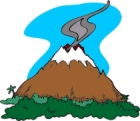
Worksheets and No Prep Teaching Resources
Reading Comprehension Worksheets
Volcanoes

Volcanoes
 Worksheets and No Prep Teaching Resources Reading Comprehension Worksheets Volcanoes |
 Volcanoes |
| edHelper's suggested reading level: | grades 3 to 4 | |
| Flesch-Kincaid grade level: | 4.66 |
|
Volcanoes and How They Form
By Brenda B. Covert |

|
 1 To understand how volcanoes form, you need to know about the layers within the Earth. The outer layer, the crust, has two parts. They are continental and oceanic. The continental crust is mostly granite, which is a light-colored rock with large crystals. This layer forms the continents. The oceanic crust is mostly basalt. Basalt is Earth's most common rock. It is a very hard, dark-colored rock that doesn't have any large crystals. The ocean floor is made up of mostly basalt. The Earth's crust is about 25 miles thick, on average, beneath the continents. Under the oceans the crust is, on average, about 4 miles thick.
1 To understand how volcanoes form, you need to know about the layers within the Earth. The outer layer, the crust, has two parts. They are continental and oceanic. The continental crust is mostly granite, which is a light-colored rock with large crystals. This layer forms the continents. The oceanic crust is mostly basalt. Basalt is Earth's most common rock. It is a very hard, dark-colored rock that doesn't have any large crystals. The ocean floor is made up of mostly basalt. The Earth's crust is about 25 miles thick, on average, beneath the continents. Under the oceans the crust is, on average, about 4 miles thick. |
Create Weekly Reading Books
Prepare for an entire week at once! |
| Leave your feedback on Volcanoes and How They Form (use this link if you found an error in the story) |
 |
Volcanoes
|
 |
Science
|